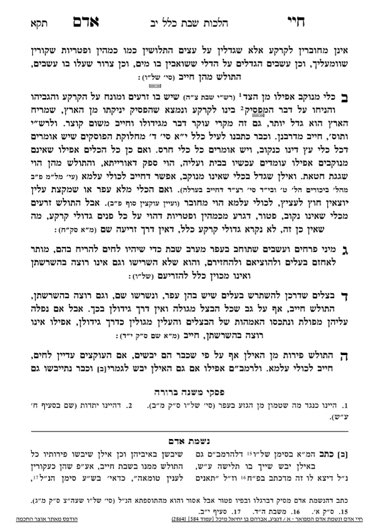Sponsorships for the upcoming Klalim, which discuss the 39 melachos of Shabbos, are available. Please contact Rabbi Reingold for more information at rabbireingold@gmail.com or 301.996.5910
We are continuing in siman 2. We left off with the Chayei Adam discussing the difference in halacha between plants in a pot and a tree within a pot without a hole. This difference is based on a Yerushalmi, which differentiates between plants and trees in a pot regarding certain halachos. The Rambam follows this difference regarding orlah, in that a tree is not chayav in orlah until it is planted in the ground. We know that plants that in a pot with a hole, are considered in the ground, but if the pot does not have a hole, they are not considered as being in the ground. He adds that trees are not the same as plants in this regard , and even in a pot with no hole, the tree is considered in the ground and chayav in orlah.
The Mishneh Lamelech discusses whether we apply this halacha to Shabbos as well. In other words, would it be considered kotzair to cut or move a tree which is in a pot which does not have a hole. The Mishneh Lamelech clarifies that the case of a tree in a pot which does not have a hole is a case where there is no dirt in the pot. If the pot has dirt, the tree is effectively in the ground due to the dirt. This is different from plants, where dirt in a pot without a hole is not considered connected to the ground.
In a situation where some of the branches of a tree in a pot extend over the ground, such that they can absorb from the ground and absorb nutrients, the branches will give the status of being connected to the ground, and it will be considered kotzair deoraysa. Thus, even according to Rashi and Tosfos, who hold that a plant in a pot is not considered connected to the ground (and therefore not subject to kotzair mideoraysa), they would agree that a tree in this situation would be considered connected to the ground and subject to kotzair deoraysa.
The Chayei Adam raises a question. We learned (s347) that even moving items which do not grow attached to the ground, such as mushrooms, are subject to kotzair mideoraysa. If so, we should not differentiate between pots which have a hole or do not have a hole, because even if they do not have a hole, they should be subject to kotzair deoraysa just like mushrooms.
The Chayei Adam explains that these cases are different, since it is not normal to plant plants in such a manner. Mushrooms and the like are normally planted in this way. Based on the rule that we said, that removing something from its growth medium is kotzair, even though they do not receive a bracha of haadama, they are still are being removed from their normal growth medium, as opposed to a tree in a pot without a hole, which is not a normal growth medium for a tree.
Summary
It is possible for a plant to absorb nutrients from the ground without directly touching the ground. Therefore, removing a plant which was already absorbing nutrients in such a manner is kotzair.
Similarly, these halachos apply to materials which are porous, such as earthenware and wood.
These halachos apply both to plants and trees. However, regarding a tree specifically, even if the tree is in a pot without a hole with dirt, it will also be considered connected to the ground, even though the same would not be true regarding plants.



